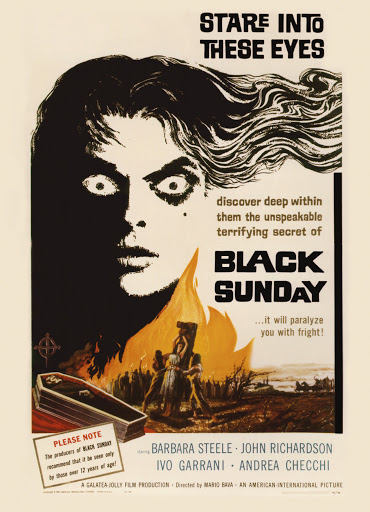Film Review: Black Sunday (1960)



Black Sunday is kind of like an amusement park ride. Not a rollercoaster or the Tilt-A-Whirl, but one of those cheesy haunted house rides—the kind where a little cart takes you from weird scene to weird scene on a loud and bumpy track. Coffins open and lights suddenly turn on to reveal skeletons or vampires. There are cobwebs everywhere, distant screams are frequent, and organ music. So much organ music. I love those kinds of rides.

It may sound like I’m selling Black Sunday short (or The Mask of Satan or Revenge of the Vampire depending on which version you stumble on), but that’s not my intention. I enjoyed the hell out of it, even if it isn’t any sort of masterpiece. It opens with a disclaimer that it is not intended for children—and indeed it isn’t (at least not 1960s children). The opening sequence, in which a Lucifer loving witch (Barbara Steele) is condemned to death, is brutal even by today’s standards (at least mine). It’s a nasty affair full of old world paranoia and good old Satan worshipping. I’d say it sets the mood nicely.

From there it gets a bit campy—but in a good way. In a nutshell, two centuries have passed and the curse the witch placed on the home of her accusers begins to come to fruition with the help of two unwitting traveling doctors (John Richardson and Andrea Checchi). Her corpse and that of her companion’s (Arturo Dominici) begin to reanimate and wreak havoc on the countryside. It’s familiar ground but executed with an immense sense of style. The film’s director, Mario Bava, would go on to be the most famous of all the giallo directors, with Black Sunday being credited as the first in a long line of these Italian horror/thrillers (Argento and Fulci being the other two heavy hitters of the genre).

The acting may be cheesy, the dialogue laughable at times, and there are enough plot holes to fill a crypt, but despite all of this, Bava has some neat tricks up his sleeve. His camera moves in ways that you don’t see in these types of genre or exploitation films. Long takes and tricks of light manage to provide genuine shocks and plenty of creepy moments. Watch how the camera quickly zooms in on an area while simultaneously lighting it to reveal something important. It’s brilliantly simple.

It’s easy to make comparisons to any of the Universal or Hammer horror pictures, but there’s something different at work here. The world that’s created is more akin to Charles Laughton’s The Night of the Hunter (1955) than to any monster movie I can think of. There’s an ethereal and dreamlike aspect to Sunday that many of the classic horror films lack. This quality allows its scarier moments to be much more nightmarish than those old camp-fests ever were. Aside from the giant rubber bat, Bava uses his special effects better than most. The eyeballs, the blood splatter, and the ghoulish make-up all add to the fun and the atmosphere. I particularly enjoyed the aging effect used on Barbara Steele’s Katia/Asa. It’s an old trick (also used extremely well in Rouben Mamoulian’s 1931 version of Dr. Jekyll and Mr. Hyde—a very disturbing film for its, or any time), but it works so well you’ll have a tough time believing it was created in 1960.

Gothic horror films come with built-in camp. It’s unavoidable. The more seriously you take yourself often serves to simply intensify this camp. Personally, I like camp. I don’t mind cheesy dialogue or bad sets if everyone is having fun. Black Sunday is fun, no doubt, but it’s also got a great creep factor due to its excellent cinematography and effects. My list of “best corpses digging themselves out of graves scenes” isn’t a very long one, but Black Sunday’s certainly must be among the best. How’s that for an endorsement?
